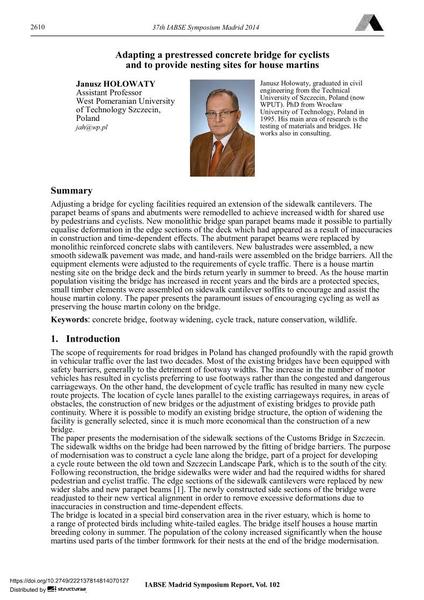Adapting a prestressed concrete bridge for cyclists and to provide nesting sites for house martins

|
|
|||||||||||
Détails bibliographiques
| Auteur(s): |
Janusz Hołowaty
|
||||
|---|---|---|---|---|---|
| Médium: | papier de conférence | ||||
| Langue(s): | anglais | ||||
| Conférence: | IABSE Symposium: Engineering for Progress, Nature and People, Madrid, Spain, 3-5 September 2014 | ||||
| Publié dans: | IABSE Symposium Madrid 2014 | ||||
|
|||||
| Page(s): | 2610-2617 | ||||
| Nombre total de pages (du PDF): | 8 | ||||
| Année: | 2014 | ||||
| DOI: | 10.2749/222137814814070127 | ||||
| Abstrait: |
Adjusting a bridge for cycling facilities required an extension of the sidewalk cantilevers. The parapet beams of spans and abutments were remodelled to achieve increased width for shared use by pedestrians and cyclists. New monolithic bridge span parapet beams made it possible to partially equalise deformation in the edge sections of the deck which had appeared as a result of inaccuracies in construction and time-dependent effects. The abutment parapet beams were replaced by monolithic reinforced concrete slabs with cantilevers. New balustrades were assembled, a new smooth sidewalk pavement was made, and hand-rails were assembled on the bridge barriers. All the equipment elements were adjusted to the requirements of cycle traffic. There is a house martin nesting site on the bridge deck and the birds return yearly in summer to breed. As the house martin population visiting the bridge has increased in recent years and the birds are a protected species, small timber elements were assembled on sidewalk cantilever soffits to encourage and assist the house martin colony. The paper presents the paramount issues of encouraging cycling as well as preserving the house martin colony on the bridge. |
||||

